Lot of this going on. Not art on a table, but table as part (or entirety) of the art.
Little lamb if you are able
Turn yourself into a table
– fragment from Irish fairy tale
Here’s three that deserve more play.

Regina Hackett takes her Art to Go
Lot of this going on. Not art on a table, but table as part (or entirety) of the art.
Little lamb if you are able
Turn yourself into a table
– fragment from Irish fairy tale
Here’s three that deserve more play.

Making is thinking. When the conclusions of the process are shown, it’s thinking aloud.
Andreas Bee considers the meaning of shelter at Suyama Space. (Beth Sellars curator. Through Aug. 14)
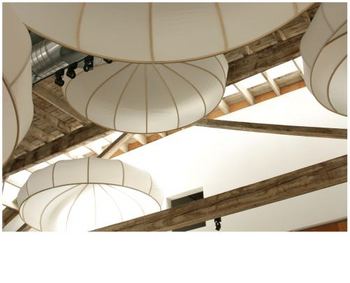 His floating sculptures on thin, bendable wooden-strip supports resemble hats, umbrellas, clouds or pup tents. They are shelters deprived of function, as there is no sky in a gallery and no need for protection against the elements.
His floating sculptures on thin, bendable wooden-strip supports resemble hats, umbrellas, clouds or pup tents. They are shelters deprived of function, as there is no sky in a gallery and no need for protection against the elements.
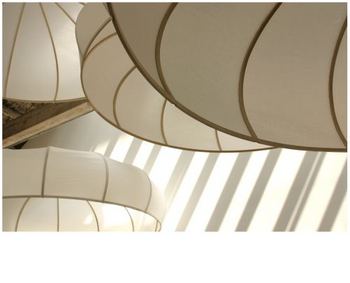 They are intrusions that slid into space with the grace of a ballet dancer pretending to be a butler. The audience is free to wander where it wants, but everywhere it goes, it is in relation to the structures hanging high or low throughout the expanse. When people stand under one, they perceive themselves wearing light like a shawl. Those on the outside see those inside as torsos with stylized cloud heads. At the opening, it was hard to keep talking. Instead, attention gravitated toward Bee’s wordless thought bubbles, how they slowly swayed in the room’s air currents, took up all the space without dominating it and served as advocates for the Herman Meville school of art, promulgated in 1851 in Moby Dick:
They are intrusions that slid into space with the grace of a ballet dancer pretending to be a butler. The audience is free to wander where it wants, but everywhere it goes, it is in relation to the structures hanging high or low throughout the expanse. When people stand under one, they perceive themselves wearing light like a shawl. Those on the outside see those inside as torsos with stylized cloud heads. At the opening, it was hard to keep talking. Instead, attention gravitated toward Bee’s wordless thought bubbles, how they slowly swayed in the room’s air currents, took up all the space without dominating it and served as advocates for the Herman Meville school of art, promulgated in 1851 in Moby Dick:
Do not reflect, compare, analyze, possess, but flow in and through, endlessly, like music.
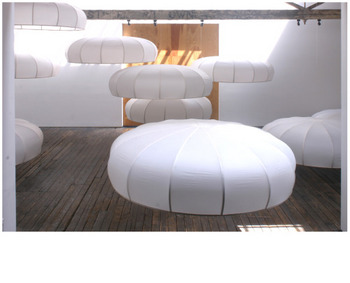 Martin Puryear is a member of the Melville School, which advocates thinking without words, through materials. In their myriad-minded manifestations, so are Robert Irwin and Cris Bruch. For starters.
Martin Puryear is a member of the Melville School, which advocates thinking without words, through materials. In their myriad-minded manifestations, so are Robert Irwin and Cris Bruch. For starters.
Via (Click to enlarge.)
Continued from this post.
Vital 5‘s Arbitrary Art Grant ($500) in the performance art category went to somebody who showed up to check it out.
From Dino Martini, gallery dealer on the scene:
Many, many people driving or walking by of course believed it was a “real” protest against performance art… In the end, a protester by the name of Garrett Hobba took the prize of $500 in $5 dollar bills. He showed up to see
what the situation was and ended up winning. (Vital 5’s) Greg (Lundgren) let his intern pick by using a rifles scope (minus the rifle) from across the street. Whoever she pointed
at first won.
Lundgren sent the images below. Only in an arbitrary world would Hobba, a musician, top these visual artists in their own game. No wonder they’re protesting. No justice, no peace. Click to enlarge.

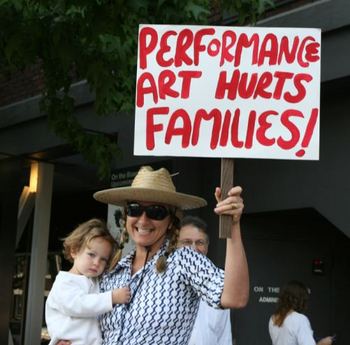
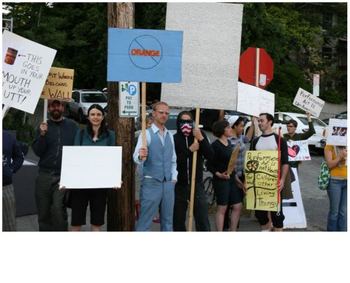 Other performance art protests that were in the end, performance art, include Kelly Mark’s Demonstration in Toronto in 2003 (restaged in front of the Henry Gallery in 2006) and Anna Halprin’s Blank Placard Happening from 1968, restaged in Portland, Oregon, last year. In the photo immediately above, FlatChestedMama restages Halprin and Mark, proving that something can come from nothing.
Other performance art protests that were in the end, performance art, include Kelly Mark’s Demonstration in Toronto in 2003 (restaged in front of the Henry Gallery in 2006) and Anna Halprin’s Blank Placard Happening from 1968, restaged in Portland, Oregon, last year. In the photo immediately above, FlatChestedMama restages Halprin and Mark, proving that something can come from nothing.
Mark’s Web site here. Her version of pointlessly rousing the rabble came equipped with blank slogans:
What do we want… NOTHING!!!
When do we want it… NOW!!!”
Hell No…We Don’t Know.
When he was exasperated, which was often, the voice of long-time PI A&E editor Duston Harvey carried across the newsroom. Even though I sat next to him, he regularly forgot to lower it for a private exchange.
Harvey: Jesus Christ, Regina. Your lead is dead.
Me: Don’t you admire its conceptual rigor?
Harvey: Even if there were hope, which there isn’t, I don’t have time for CPR.
Although (and sometimes because) he could be abrasive, sarcastic, impatient and a tough sell for an art critic, I remember our time together fondly. He could find clarity in a muddle and never lost sight of the ultimate goal: to connect to a general audience without losing the interest of the already on-board.
Before Billy Howard moved his gallery (Howard House) to Pioneer Square, he was unhappily in Belltown. Howard had grown sick of the intrusions of the drug trade and asked me to write a story about it, here. The day it appeared, a member of the community he deplored approached him on the street to suggest he and his ilk were displeased by the tone of the coverage. Then the dealer in drugs punched the dealer in art in the face.
While expressing sympathy for a bruised friend, I felt a secret and shameful thrill. Drug dealers are reading art stories!
One day on the Vashon Ferry, I saw a woman pick up the PI’s entertainment section and page through. She read Gene Stout (rock) and William Arnold (movies). Theater she treated with a once-over-lightly scan, and classical music she skipped entirely. Her eyes fell on my page. I waited. She read the headline, looked at the picture and passed me by. Had I been sitting closer, I might have tried to talk her into reconsidering. (Ok, the lead’s slow, but you might be interested in…)
If I connected with any public outside the previously committed, I’m not aware of it, but I appreciated the decades-long, never-say-die chance to try.
Time to say die.
Art magazines and art blogs are the journalistic equivalent of studio art, while an art review in a newspaper is like public art. Anyone from any background might happen upon it.
Where I write now does not exist in a generalized public sphere. A street sweeper on coffee break will not happen upon a leftover copy of this blog and be drawn into a review. A woman getting her heels buffed won’t find it on the empty seat beside her and be motivated to see an exhibit of which she might otherwise not have heard.
For an art critic, the death of newspapers is the death of potential connection to wider worlds. Everyone who reads this blog has a preexisting condition, otherwise known as an interest in art.
On the other hand, there are notable benefits. Where I’m writing now, nobody tells me what to do and nobody derides my blog just because it’s a blog.
Below, the thoughts on blogs from the final three (in the final two years) PI A&E editors.
Duston Harvey (my favorite by a mile): You’re wasting too much time on that blog.
Emily White: I hope you don’t think I have time to read your blog.
John Levesque: I hate blogs. (Big sigh)
Via.
Seattle’s Vital 5 finds the process of applying for grants demeaning and the results arbitrary. Hence, it launched its Arbitrary Art Grants.You don’t have to be good to win. On the other hand, if you’re fabulous, Vital 5 won’t hold it against you. $500 to each lucky winner. More here.
Last Friday, Vital 5 awarded another $500 dollars to somebody (anybody) with a sign protesting performance art in front of On The Boards, in honor of its NW New Works Festival.
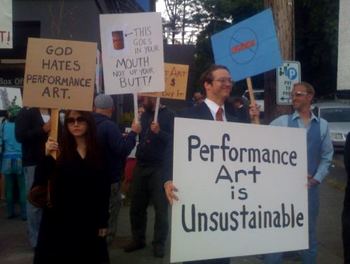 Photo, Dino Martini. Four in front, left to right: Emily Pothast (God Hates Performance Art); Steven Miller (This Goes In Your Mouth Not Up Your Butt!); Jed Dunkerley (Performance Art Is Unsustainable) and John Sutton of SuttonBeresCuller (unreadable from here).
Photo, Dino Martini. Four in front, left to right: Emily Pothast (God Hates Performance Art); Steven Miller (This Goes In Your Mouth Not Up Your Butt!); Jed Dunkerley (Performance Art Is Unsustainable) and John Sutton of SuttonBeresCuller (unreadable from here).
I love Pothast’s parody of her own interests. Ditto Miller, rabidly against what he cares about most (freedom). Dunkerley’s business consultant is a victim of his excessive self-esteem. If I were picking from the sample, Pothast would be picking up a check. Scoring aesthetically in this psudeo-protest, however, was of no value to the outcome, which is why so many artists turned out.
In her review of Dirk Skreber‘s exhibition at Fredrich Petzel, Art Fag City’s Paddy Johnson wrote,
Featuring two vagina-shaped crashed cars impaled on penile poles and bare-breasted paintings of super heroes, the show is the closest thing I’ve seen to pornography lately.
That’s a bad thing? First, it’s her idea that the smashed cars are vaginas. I like it, but it’s her metaphor. Second, although she has the advantage on me, having stood in the gallery instead of only seeing representations online, I’m pretty sure these sculptures aren’t anywhere near porn.
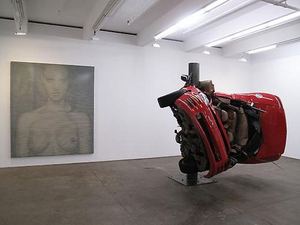 Porn is business. Ask your average male-seeks-female porn consumer if Skreber’s sculptures pass the porn test. They lack porn’s functionality. Like the Beatles in the late 1960s, porn loves to turn you on. Who’s turned on by these? I want to see hands.
Porn is business. Ask your average male-seeks-female porn consumer if Skreber’s sculptures pass the porn test. They lack porn’s functionality. Like the Beatles in the late 1960s, porn loves to turn you on. Who’s turned on by these? I want to see hands.
Because she interprets the sculptures as vaginas wrapping a phallus, she’s against them. At the risk of being an insensitive clod, I don’t see why aggressive sexual imagery has to be denigrated or denigrating. The heart is a corkscrew. Art from the heart doesn’t always dress for dinner or pass muster in a women’s studies class. My version of feminism does not foreclose on desires (even rage-filled desires) that have no victim.
In spite of stepping off the cliff from time to time (who doesn’t?), Johnson is essential. Here’s an example of why.
Kenneth Baker’s review of Squeak Carnwath at the Oakland Art Museum opens by acknowledging the broad general view and sympathizing with it:
It took me a long time to warm to Squeak Carnwath’s painting.
Twenty years ago, I regarded it as a self-involved pastiche of outsider-art mannerisms. But the Oakland Art Museum’s survey of the past 15 years of Carnwath’s work makes a nearly irresistible case for its authenticity and substance.
I’m not persuaded, but the review is so powerful I’m left feeling that I need to see this show before continuing to indulge a long-standing dismissal. On the other hand, a good curator can hide major faults and stress minor virtues, which might be all that happened here.
Baker again, on Robert Frank:
Part of Frank’s originality was to institute the photograph as a
membrane responsive both to a moment’s reality and the photographer’s
feelings about it.
Holland Cotter on the heart of the matter at the Met’s African/Oceanic survey:
In the Michael C. Rockefeller Wing at the Metropolitan Museum you’ll find a tiny African copper relief that probably predates, and would surely have awed, the great Lorenzo Ghiberti. You’ll encounter a bust of a Nigerian beauty to rival Nefertiti; an Oceanic Apollo with the physique of an Olympian; and a Micronesian statuette that is, with its stacks of faceted planes, Brancusi before Brancusi. (Review here.)
Cotter again, on Giacometti:
These portraits are laborious, noodling things, their lines repeated
over and over as if Giacometti were determined to create something
solid from nothing, then to obliterate that something. Far more relaxed
— and surely Giacometti drew as compulsively as he did to relieve
tension — are the drawings that look incidental, on the fly: an empty
studio interior, apples in front of a window, a pot of tulips, a tree.
Heaviness lifts; anxiety is dispelled. The faint lines of the tree fly
outward and upward like flames, evidence of a lightened-up, fly-away
artist that some part of Giacometti may always have wanted to be.
From Culture Monster, Daniel Nicoletta’s portraits of Harvey Milk, A life (cut short) in pictures, here.
Also from Culture Monster, David Pagel’s fine review of Kelly McLane: (Yes, description still mattters.)
In “Zero Gravity Madonna Lab,” plump pink babies grow like hothouse
tomatoes as older kids, in hermetically sealed bubbles, evoke science
experiments gone wrong. In “Flaming Arrow,” a sunny sky rains cherubic
cowgirls as a monstrous maw opens in the desert floor to devour
everything around it.Her paintings add depth and color to such point-blank encounters,
making the grand sweep of history come alive. If her oils and acrylics
on canvas were novels, they would have a lot in common with works by
Mark Twain, Wallace Stegner and Thomas Pynchon.
Pagel again: His review of Pae White is a thing of beauty:
Over the last couple of decades, Pae White has made art out of
almost nothing but thin air: a handful of cat whiskers affixed in a
drop of glue, a spray-painted spider web set in resin and the
shimmering reflections cast from a slab of mirrored Plexiglas sheets.
At 130PE, the light-handed artist
continues her lighthearted gambit, transforming incidental things into
instances of wonder that are ripe with delight.What’s new is the delicate touch of melancholy. Smoke and leaves are
the vehicles for White’s casually exquisite installation, which
consists of woven tapestries, laser-carved sheets of brightly colored
paper and hundreds of fake leaves, all made mechanically and many
painted, stained and shaped by hand.
From Jen Graves, definitive piece on commercial ventures borrowing or stealing from artists, here. Facts cited and complexities illuminated.
Graves again: She offers to take note in a public artist’s support group – real interviews in an imaginary frame. Funny, true and frightening, here.
From Sebastian Smee at the Boston Globe, a dud of a review of Matthew Day Jackson. Smee looks for polish and misses the power of the artist’s hungry heart.
Smee is in his 30s but writes as if he’s more than twice that age, cozying up to the audience as if he’s entertaining it over brandies in a men’s club. Even when he’s writing well, which is frequently, I feel like shaking the smug out of him. Maybe that’s all he needs – one good shake.
(Note to Smee: Get rid of most of your adjectives and step off your high horse. Treat your reading audience as if it’s a collection of intelligent but potentially dangerous strangers you’ve been hired to engage. Do not speak for them, pat them on their heads or presume to anticipate their reactions, and you’ll be fine.)
Via (Photo, Rod Campbell)

We’re all normal and we want our freedom.
Marat/Sade
an ArtsJournal blog


